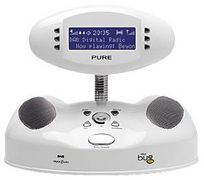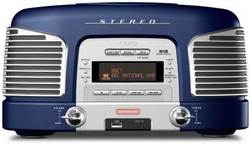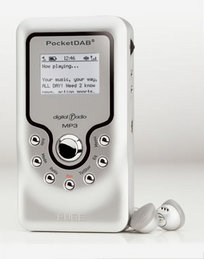13 November 02005
The slow evolution of DAB digital radio devices
My excitement and predictions about the Bug — the digital radio that can pause, rewind, record and convert to MP3 (pictured right) — seem so far to have been overstated.  Sixteen months ago, I said I'd trade my iPod for a Bug, and just over eleven months ago I recorded the prediction: "next year it will be possible to download the programme guide to your Bug digital radio, set it to record your favourite programmes for the week onto flash memory and then copy them to your iPod" (I can't honestly remember whether that originated with me or someone else at the event I was writing about).
Sixteen months ago, I said I'd trade my iPod for a Bug, and just over eleven months ago I recorded the prediction: "next year it will be possible to download the programme guide to your Bug digital radio, set it to record your favourite programmes for the week onto flash memory and then copy them to your iPod" (I can't honestly remember whether that originated with me or someone else at the event I was writing about).
In the intervening period, iPods have gone through several generational changes (including the introduction of the iPod Mini in the UK, followed by the Shuffle and the Nano). By comparison, the Bug seems to have more or less stood still, and is nowhere near being a pace-setter in the market. I thought I'd wait to see how the second generation Bug looked before buying one, and I'm still waiting.
At the risk of the vaingloriousness of comparing my predictions with William Gibson's, I'm reminded of an interview he gave after the 01992 Los Angeles riots where he saw looters stripping one store of TV sets and music decks, but leaving the Apple Powerbooks in the next-door store untouched. He realised that the urban disenfranchised were not persuaded by the ideas he'd been peddling, that they could use computers and networks as subversive technologies to empower themselves.
But that was in 01992, and maybe it just needed another ten years for the Internet to become truly accessible, as well as for computers to incorporate some of the capabilities of TVs and music decks along with copying, remixing and re-distributing media content.
Perhaps the Bug is at the same stage that the Powerbook was in 01992: a boon to enthusiasts and early adopters but just not connected enough to be truly mainstream. The Bug is not small enough to count as really portable, but neither is it flexible, powerful or 'big' enough to substitute for managing your digital music collection on your computer or listening to your favourite music on a hi-fi system. So, to get the most out of it, you have to connect it to your computer (and thence to your MP3 player and/or hi-fi) — and the process of doing all this via an SD card with modest storage and a USB cable is not as seamless as the iPod experience. The iPod comes with a dock, so it's natural to keep it by your computer, and anyway it's designed to be carried around. Many people don't keep their radio by their computer, and the Bug is not designed to be carried around.
One option for next-generation Bugs, then, would be to make them more portable, give them more on-board storage, and ensure the link with computer software has the same foolproof simplicity that the iTunes/iPod combination has achieved.
 Teac, meanwhile, is going down a different route by taking the computer out of the picture altogether, appealing to people who are turned off by the complexities normally associated with computers. This is embodied by the snappily-named SL-900 DAB radio/CD player (pictured right), and the Reference 200 CR-H250 CD Receiver. These products play CDs, which the Bug doesn't do, as well as digital radio. You can record either source in MP3 format — I can't find out how much storage is available — and then transfer it direct to your MP3 player via the USB port on the front.
Teac, meanwhile, is going down a different route by taking the computer out of the picture altogether, appealing to people who are turned off by the complexities normally associated with computers. This is embodied by the snappily-named SL-900 DAB radio/CD player (pictured right), and the Reference 200 CR-H250 CD Receiver. These products play CDs, which the Bug doesn't do, as well as digital radio. You can record either source in MP3 format — I can't find out how much storage is available — and then transfer it direct to your MP3 player via the USB port on the front.
While the Bug is styled (by Wayne Hemingway) as a kitsch futuristic robot, the SL-900 DAB is clearly going for the like-silicon-chips-never-happened retro look, and the tacky "No PC 4 MP3" advertising campaign for the CR-H250 (featuring an MP3 player worn by topless woman) suggest a target market that likes the feel of tech chic — model names that sound like motorbikes — even if they can't hack it with anything as a prissy as a keyboard and a mouse.
When digital radio devices with record, pause and rewind link more intimately and straightforwardly with computers, MP3 players and living-room music system, I think there may yet be good mileage in them. Last year I overlooked the importance of this intimacy and underestimated how many evolutionary cycles it will take to get to DAB consumer devices that give listeners the functions and convenience they want. It's always instructive to be shown to be wrong, but I'm not completely throwing in the towel yet.
 Update, 11 December 02005: With apologies for the oversight, I should belatedly mention Pure's PocketDAB 2000 (right), which is like a Bug that you can put in your pocket — if you have a reasonably big pocket. This review says "at £200 it's a little pricey", and I think that may be right.
Update, 11 December 02005: With apologies for the oversight, I should belatedly mention Pure's PocketDAB 2000 (right), which is like a Bug that you can put in your pocket — if you have a reasonably big pocket. This review says "at £200 it's a little pricey", and I think that may be right.

Subscribe to my RSS feed, which covers this blog, my book blog, and further commentary on other web resources (more feeds below)
Notes on Emergent Learning
School it Yourself: Review of The Edupunks' Guide and How to Set Up a Free School
What's holding Open Access publishing back?
On ecosystems, Adam Curtis and positions of power
The Whys and Wherefores of Creativity and Sharing: Review of Making is Connecting
Round-up of recent writing in other places
Purpos/ed: What's the purpose of education
Open, trusting, generous: review of Monkeys With Typewriters, a book on leadership
Do we need an agile learning community of practice?
Unplugged! The Agile Learning newspaper
Can we make a newspaper about self-organised learning?
Tony Hall on teaching by not teaching
Ollie Nørsterud Gardener: an entrepreneur's vision of peer-to-peer learning in organisations
Resilience and scaling down in the face of decline (Dougald Hine discussion, part 2)
Cinema (24)
Cultural Calendar (86)
Curatorial (66)
E-learning (102)
Events (35)
Future of Music (95)
Human-Computer Interaction (62)
Ideas and Essays (37)
Long Now (18)
Miscellany (44)
Music and Multimedia (157)
Playlists (27)
Podcasting (12)
Politics (12)
Radio (48)
Reviews (58)
Social Software (60)
Teaching (23)
Alternatively, see the Date-based Archives
Recommended: RSS feed that combines items on this site, my book blog, and commentary on other web resources
RSS feed for this site only
RSS feed for my book, Net, Blogs and Rock'n'Roll
RSS feed for shared bookmarks
My latest bookmarks (click 'read more' for commentary):
My archived bookmarks (02004-02008)
On most social sites I am either 'davidjennings' or 'djalchemi', for example: Flickr, Last.fm, Ma.gnolia and so on…
Lateral Action — managing creativity
Herd — social cognition
Seb Schmoller's e-learning mailings
Viridian Design Movement
Tom Phillips — artist
Long Now blog — resources for long-term thinking
Longplayer live stream — 1,000-year composition

The contents of this site are licensed under a Creative Commons Licence except where otherwise notified.
Hosted by Paul Makepeace
W3C Standards
Check whether this page is valid XHTML 1.0
Check whether the CSS (style sheet) is valid

